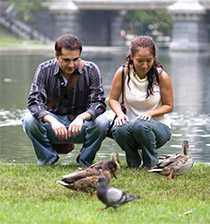NCEH State Fact Sheets: Wisconsin
CDC 24/7: Saving Lives. Protecting People from Health Threats. Saving Money through Prevention.
Environmental Health
 Your environment is everything around you—the air you breathe, the water you drink, the community around you, the places where your food is grown or prepared, your workplace, and your home. When your environment is safe and healthy, you are more likely to stay healthy. But when your environment exposes you to dangerous events or toxic substances, your health can be affected negatively.
Your environment is everything around you—the air you breathe, the water you drink, the community around you, the places where your food is grown or prepared, your workplace, and your home. When your environment is safe and healthy, you are more likely to stay healthy. But when your environment exposes you to dangerous events or toxic substances, your health can be affected negatively.
CDC is committed to saving lives and protecting people from environmental hazards by responding to natural and man-made disasters, supporting public health workers, educating communities, and providing scientific knowledge. We help maintain and improve the health of Americans by promoting a healthy environment and preventing premature death and avoidable illness caused by environmental and related factors. We also identify how people might be exposed to hazardous substances in the environment and assess exposures to determine if they are hazardous to human health. CDC invests in prevention to improve health and save money by reducing healthcare costs. We remain committed to maximizing the impact of every dollar entrusted to the agency.

Asthma
In 2008, an estimated 497,381 adults and children in Wisconsin had asthma.
From: http://www.cdc.gov/asthma/
stateprofiles/Asthma_in_WI.pdf
Funded Activities
National Asthma Control Program
(FY 2013 funding for Wisconsin—$364,000. A new funding announcement has been released; FY 2014 funding information will be available later in the year.)
Asthma is a common disease on the rise, with significant health disparities and associated healthcare costs. Nearly 1 in 12 Americans (26 million) have asthma. In the last decade, the proportion of people with asthma, grew by nearly 15%.
CDC has been working with states for more than 10 years to implement community-based interventions, build local coalitions, and track the impact of the disease on the U.S. population.
The program focuses on what works to control asthma: assessing and measuring changes in disease severity and control, using the right medications, educating people to manage their conditions, and controlling environmental irritants and allergens.
Even though the number of people with asthma has increased over the last 10 years, trends show that more are controlling their disease:

Tracking
Tracking data are available on health indicators, including asthma, birth defects, cancer, carbon monoxide poisoning, heart attacks, lead poisoning, and reproductive outcomes. Tracking data also are available on environmental indicators such as air and drinking water.
Environmental Public Health Tracking Program
(FY 2013 funding for Wisconsin—$715,000. A new funding announcement has been released; FY 2014 funding information will be available later in the year.)
The World Health Organization (WHO) estimates that nearly 25% of all diseases are caused by environmental exposures. Some of these diseases—such as cancer, asthma, and cardiovascular disease—are the greatest killers today.
CDC’s Environmental Public Health Tracking Network (Tracking Network) is a dynamic web-based tool that tracks and reports environmental hazards and the health problems that may be related to them.
The Tracking Network’s integrated health, environmental exposure, and hazard information is used to
- Identify interventions and policies to reduce or prevent health effects from environmental exposures.
- Assess and research environmental links to diseases.
- Learn more about health and environmental issues in the communities where we live.
Since 2005, the Tracking Network has led to at least 160 public health interventions that prevent or control potential health effects from environmental exposures.
Climate and Health Program
(FY 2013 funding for Wisconsin—$237,000. FY 2014 funding information will be available later in the year.)
Changes occurring in the world’s climate are affecting our health and well-being, especially among the most vulnerable of us—children, the elderly, the poor, and people with underlying health conditions.
Climate and Health Program funding for CDC is the dedicated U.S. government investment in preparing our nation to anticipate and adapt to the health consequences (increased illness and death) of climate events like extreme heat, extreme weather events, wildfires, air pollution, and insects, as well as threats to our food and water supply safety.
CDC supports
- Identifying populations most vulnerable to these effects.
- Anticipating future trends.
- Assuring that systems are in place to detect and respond to emerging health threats.
- Taking steps to assure that these health risks can be managed now and in the future.

Lead
- Of children ages 6 and under who were tested for blood lead in Wisconsin in 2011, 7,553 had blood lead levels of 5μg/dL or greater.
- *CDC’s funding to state lead poisoning prevention programs was eliminated in FY 2012 because of budget reductions.
Lead Poisoning Prevention Program
(FY 2011 funding for Wisconsin—$594,000; because of funding reductions, the program was discontinued in 2012. Some funding was restored in FY 2014. States will be recompeting for funding and more information will be available later in the year.)
More than 12 million U.S. children are exposed to lead in their homes at levels that can harm their intellectual development. No safe blood level in children has been identified.
Reducing children’s lead exposure is perhaps the greatest environmental health accomplishment in the past 20 years.
For more than 20 years, CDC funded state and local health agencies to
Children who are exposed to lead lose $3,000 to almost $8,000 in lifetime productivity for each 1 microgram per deciliter (μg/dL) increase in blood lead level. Blood lead levels over 1 μg/dL are associated with measurable reductions in IQ.
Between 2007–2008 and 2009–2010, interventions that control or eliminate lead hazards before children are exposed (primary prevention) helped reduce the number of children exposed to lead (blood lead levels ≥ 1μg/dL) by nearly 3 million, saving $26–57 billion in lifetime productivity earnings alone. These estimates do not account for behavioral and other adverse effects on lifetime productivity linked to lead.
Built Environment and Health Initiative1
The way we design and build our communities can affect our physical and mental health. Public health challenges like asthma, motor vehicle-related injuries, obesity, and heart disease are directly related to how communities are designed and built.
CDC’s Built Environment and Health Initiative is the only source of federal expertise to help states and communities integrate health considerations into transportation and community planning. Strategic community design can increase physical activity, reduce injuries, improve air and water quality, and minimize contributions to climate change.
CDC’s Built Environment and Health Initiative
1Built Environment and Health Initiative is also known as Healthy Community Design Initiative. http://www.cdc.gov/healthyplaces
Public Health in Action
Asthma Prevention in Wisconsin
Since 2002, more than 850 primary care doctors have been trained by a partnership of the Children’s Health Alliance of Wisconsin, Fight Asthma Milwaukee Allies, the Medical College of Wisconsin, the Wisconsin Academy of Pediatrics Foundation, the Wisconsin Asthma Coalition, and the Wisconsin Medical Society. An allergist and a nurse took the Allergist Outreach Asthma Education Program directly to primary care clinics for pediatricians, family practice physicians, nurse practitioners, nurses, respiratory therapists, and other clinical staff. Reviews of the program showed significant improvements in severity classification, assessment of dust as a trigger, and writing a care plan. Physicians and nurses also reported improvements in teaching persons with asthma and in staff teamwork. Adapting to changing needs in Wisconsin, the Allergist Outreach Program has evolved into short regional training sessions that reach larger audiences. The American Lung Association of the Upper Midwest has taken the Allergist Outreach Program on the road and now conducts in-clinic and regional training sessions in Minnesota, North Dakota, Ohio, South Dakota, and Wisconsin.
Tracking Agricultural Pesticide Use in Wisconsin
Agriculture accounts for more than 40% of Wisconsin’s economy. Health officials in Wisconsin wanted a better understanding of the effect of agricultural pesticide use on drinking water contamination and related health outcomes.
The Wisconsin Tracking Program worked with the state agricultural agency to develop a database that geographically categorizes areas of high, medium, or low pesticide use. This tool has been used to identify environmental contaminants that may be linked to childhood cancers. By integrating many sources of information, it provides a better understanding of the hazard and the potential for exposure to agricultural pesticides.
The Wisconsin Tracking Program’s work significantly advances knowledge of the potential for pesticide exposure via drinking water. It can be used to explore associations between pesticides and such adverse health effects as cancer, thus making regulatory data more useful for public health. The tool is a model that can be replicated by others who want to learn about health risks related to pesticide use.

Climate and Health
Between 1950 and 2006, Wisconsin’s annual average temperature increased 1.1 degrees Fahrenheit, while its annual precipitation increased 3.1 inches.
Climate and Health Program in Wisconsin
CHP’s current 4-year grant to Wisconsin is through the Climate-Ready States and Cities Initiative (CRSCI). The Wisconsin Department of Health Services (WDHS) is using the grant to build resilience against health-related climate effects in Wisconsin communities. Specifically, WDHS is incorporating model-based, future climate change scenarios into long range public health planning and preparedness activities. This helps the department to identify vulnerable populations and develop systems to detect and respond to present and future climate-related health threats. With the help of CDC experts, WDHS is also working directly with local agencies to assess and respond to the effects of climate change in their communities.
The CRSCI grant follows a 3-year CHP research grant that brought together science and public health on the issues of climate change. WDHS worked with the University of Wisconsin-Madison, UW-Milwaukee, the Medical College of Wisconsin, the U.S. Geological Survey, and the U.S. Department of Agriculture to combine data on health, hydrology, and climatology to predict the relationship of climate conditions to health risks over the next 50 years.
Studies have already shown that severe weather events will become nearly three times more frequent in coming years. A public health leader participating in the Wisconsin project noted, “If you’re having periodic flooding events, you can’t assume they are ‘once-in-100 years’ events. Data modeling indicates that this trend will only get worse.” Wisconsin has already begun preparing. With further funding, the state can move from research to planning and policy changes that will protect people from the potentially harmful effects of weather-related events associated with climate change.
Wisconsin’s Lead Poisoning Prevention Program
In 2009, it was estimated that Wisconsin had more than 400,000 housing units with lead paint hazards. Approximately 90% of children identified with elevated blood lead levels live in housing units built before 1950.
The following is a description of activities carried out in in previous years with the support of CDC’s Lead Poisoning Prevention Program when it was fully funded:
Local health departments provide blood lead screening, care coordination, nursing case management, environmental management, surveillance, community education, and early intervention services within their communities. Nurses trained in lead prevention conduct outreach to pregnant women, identify potential lead hazards, and train families in lead hazard reduction techniques. WHHCLPPP provides funding and support to all 96 of Wisconsin’s local health departments for lead prevention activities. CDC also provided funding to Milwaukee, Racine, and the Wisconsin Council on Children and Families to implement comprehensive interventions. The Wisconsin Council on Children and Families promotes awareness of childhood lead exposure by providing information about lead hazards to early childhood educators, parents, child advocates, and policy makers.
Children from low-income and refugee families are considered to be at high risk for lead exposure within the state. WHHCLPPP targets families living in high-risk communities and children enrolled in Medicaid and the Women, Infants, and Children (WIC) program for screening, education, prevention, and treatment. To target refugee children at high risk for lead exposure, WHHCLPPP screens refugee children for blood lead levels upon their arrival in the state and after moving into permanent housing. In 2007, over 90% of refugee children were tested within 3 months of arrival. The state also conducts educational sessions with refugee families, resettlement workers, and health care provider staff about the necessity and availability of testing.

Built Environment & Health
- Communities use CDC’s tools to build infrastructure that maximizes good health.
- From 2009-2010, Wisconsin developed an HIA toolkit, and provided two trainings and three webinars for local and state agency staff on the HIA framework.
Built Environment and Health in Wisconsin
With support from CDC, the Wisconsin Bureau of Environmental and Occupational Health was active in state capacity building efforts to make the built environment healthier through HIAs. Over 74 individuals from government, academia, advocacy organizations, agencies, local health departments, and community partners attended the bureau’s 2-day trainings on the HIA framework. Over 81 viewers participated in the 3-part HIA Webinar series. CDC funded the bureau’s HIA pilot projects and provided technical assistance. One project aimed to understand the health impact the remediation and stabilization the Lincoln Park area and reconstruction of the Milwaukee River Estuary on residents. Another project aimed to determine the health impacts of the proposed development and expansion of the Ice Age Trail, a National Scenic Trail, on Marquette County citizens. The bureau developed resources, including a Wisconsin-specific HIA Online Toolkit, a Working Model for HIA in Wisconsin through feedback and input from focus groups comprised of local health department staff, and educational materials to increase awareness of HIA and the HIA toolkit. As a result of these activities, the bureau was invited to a range of discussions where health had not formerly been integrated into the decision-making processes, such as the planning process for the Wisconsin Department of Transportation’s Wisconsin Rail Plan 2030. Furthermore, the bureau collaborated on multiple HIA-related grant proposals with new and diverse partners.
Top of Page- Page last reviewed: April 29, 2014
- Page last updated: April 29, 2014
- Content source:


 ShareCompartir
ShareCompartir